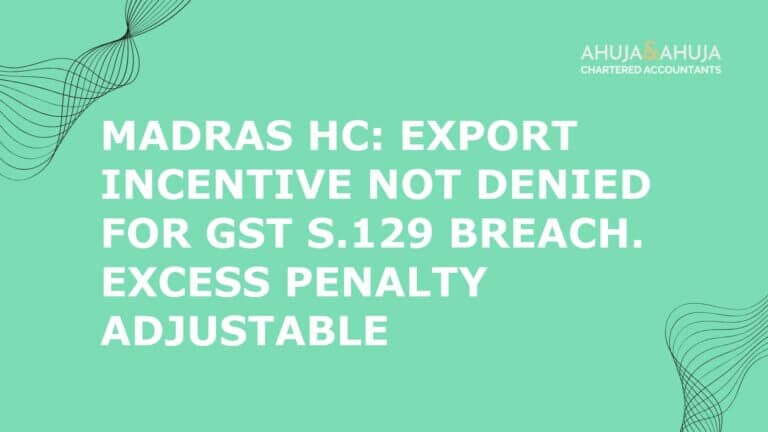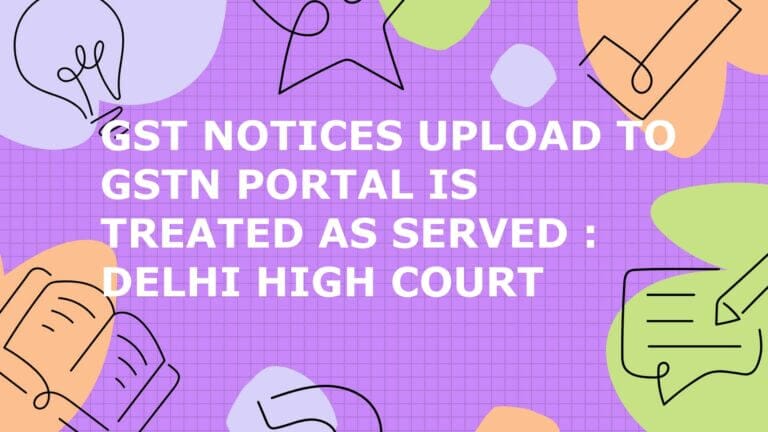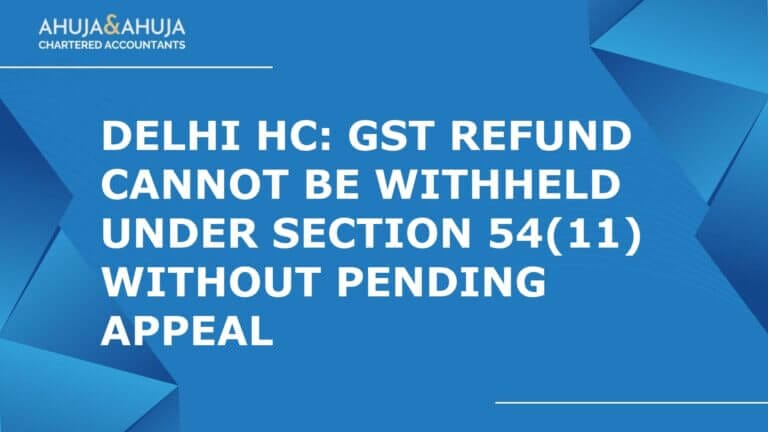AAAR Lacks Power to Condone Delay Beyond 60 Days under Section 100(2) CGST
Executive Summary
The Appellate Authority for Advance Ruling (AAAR) under the CGST Act is bound by a strict statutory limitation: appeals must be filed within 30 days from the date the Advance Ruling (AAR) order is communicated, with a possible extension of not more than 30 additional days if sufficient cause is shown. This means the absolute outer limit is 60 days—no more, no less.
If an appeal is filed even a day after this 60-day window, the AAAR has no legal power to condone the delay, regardless of the reason. The authority is a creature of statute, not a court, and cannot exercise any inherent or discretionary powers beyond what the law expressly provides. As a result, appeals filed after the 60-day period are non-maintainable—the AAAR cannot even consider the merits or the reasons for the delay.
For CFOs, tax heads, and compliance teams, this is not just a technicality—it is a hard stop that can result in the complete loss of the right to appeal, no matter how strong the underlying case. Delays often arise from internal approval bottlenecks, inter-departmental dependencies, or simple oversight. The consequences, however, are severe and irreversible.
This article unpacks the legal position with a judgments-first approach, anchored by the recent Kanishk Steel Industries Ltd., In re (2025 Tamil Nadu AAAR) decision. It then moves beyond theory to offer practical compliance strategies: how to diarize deadlines, set up escalation protocols, communicate the non-extendable nature of the limitation, and use simple tools like deadline calculators and checklists. For those who miss the window, we also outline the limited but critical option of writ relief before High Courts, and what documentation is needed for such a challenge.
Key takeaway:
The 60-day deadline for AAAR appeals is absolute. Prevention—through robust compliance processes and clear internal communication—is the only reliable cure. Once the window closes, the statutory right to appeal is lost, and only extraordinary writ remedies may remain.
For expert assistance with GST litigation and compliance, companies can consult experienced GST Litigation Services teams based in locations such as Delhi and Chandigarh.
Judgments-First: Recent Precedents & Legal Standpoint
A. Case Spotlight: Kanishk Steel Industries Ltd., In re (2025 Tamil Nadu AAAR)
The recent decision in Kanishk Steel Industries Ltd., In re (2025) is a textbook example of how strictly the AAAR applies the limitation period under Section 100(2) of the CGST Act. Here, the appellant received an adverse AAR order on 6 February 2025, communicated on 7 February 2025. The law gave them 30 days to appeal, with a possible extension of another 30 days for sufficient cause. However, the appeal was filed on 23 June 2025—105 days late.
The appellant’s reason for delay was the time taken to secure approval from the Tamil Nadu Green Energy Company Limited (TNEGCL). The AAAR, however, dismissed the appeal outright as time-barred, holding that it had no jurisdiction to condone any delay beyond the 60-day statutory maximum. The authority did not even examine the merits of the ITC claim or the sufficiency of the cause for delay. The message was clear: statutory timelines are absolute, and the AAAR’s hands are tied.
For detailed understanding of ITC issues related to such rulings, refer to this blog on Duty Credit Scrips: GST Impact and Input Tax Credit (ITC) Reversal Explained.
B. Extracts: Interpreting Section 100(2) CGST—“not exceeding thirty days”
Section 100(2) of the CGST Act reads:
“Every appeal under this section shall be filed within a period of thirty days from the date on which the ruling sought to be appealed against is communicated…
Provided that the Appellate Authority may, if it is satisfied that the appellant was prevented by sufficient cause from presenting the appeal within the said period of thirty days, allow it to be presented within a further period not exceeding thirty days.”
The phrase “not exceeding thirty days” is the statutory brick wall. Courts and authorities have consistently held that where the law prescribes a maximum condonable period, the authority cannot go beyond it, even for compelling or sympathetic reasons. The AAAR’s power to condone delay is strictly limited to this additional 30 days—no more.
For insights on related statutory interpretation, read our detailed post on Understanding the Impact of New GST Section 74A: A Complete Analysis.
C. AAAR as a Statutory Authority: Limited by Express Legislative Delegation
The AAAR is not a court of equity or a general tribunal—it is a creature of statute. Its powers are confined to what the CGST Act expressly grants. Unlike High Courts, which have inherent and extraordinary powers under the Constitution, the AAAR cannot “read in” powers that the law does not provide. The principle of expressio unius est exclusio alterius applies: what is expressly mentioned (a 30-day condonable period) excludes all else (any further extension).
This position has been affirmed in several GST and allied tax law cases, where appellate authorities have refused to entertain appeals filed even a day late beyond the statutory maximum. The AAAR’s lack of inherent or residual power means that once the 60-day window closes, the door is shut for good—no matter how genuine the reason for delay.
Statutory Architecture: Section 100(2) CGST Explained
A. The Absolute Timeline—Calculation Step-by-Step
- Date of Communication: The clock starts ticking from the date the AAR order is communicated to the applicant.
- Initial 30 Days: The appeal must be filed within 30 days of this communication.
- Condonable 30 Days: If there is a sufficient cause, the AAAR may allow a further period of up to 30 days—but not beyond.
- Absolute Deadline: The last permissible date is 60 days from the date of communication. Filing even a day late makes the appeal non-maintainable.
Example Calculation:
- AAR order communicated: 7 February 2025
- 30 days: 9 March 2025
- Additional 30 days (if condoned): 8 April 2025
- Absolute last date: 8 April 2025
Deadline Calculator (Box-Out):
- Date of AAR order communication: [ ]
- Add 30 days: [ ]
- Add further 30 days (if condonable): [ ]
- Absolute last date to file appeal: [ ]
For a structured approach to documentation and deadlines, tax teams can benefit from GST Return Filing Services support provided by firms with offices in Moradabad and Ghaziabad.
B. No Inherent/Discretionary Power for Condonation Beyond 60 Days
The language of Section 100(2) is unambiguous. The AAAR “may… allow it to be presented within a further period not exceeding thirty days.” There is no scope for reading in any further discretion. The legislative intent is to provide certainty and finality to advance rulings, and to prevent endless litigation.
The doctrine of expressio unius est exclusio alterius—to express one thing is to exclude another—applies squarely. Since the law expressly allows only a 30-day condonable period, it excludes any further extension. The AAAR cannot invoke any “inherent” or “equitable” power to go beyond what the statute says.
Key Takeaway:
The AAAR’s power to condone delay is strictly limited to a maximum of 30 days beyond the initial 30-day period. Appeals filed after 60 days from the date of communication of the AAR order are non-maintainable, regardless of the reason for delay. The authority cannot examine the merits or the cause for delay once the statutory window closes.
For broader understanding of similar limitation issues, see the blog on GST Appeals – 4 Months Limitation Not Set in Stone, Decide on Merits: High Court.
Legal Consequences: Appeals Beyond 60 Days
Missing the 60-day deadline for filing an appeal before the AAAR is not a mere technical lapse—it is a legal dead end. Once the statutory window closes, the consequences are immediate and absolute.
Non-Maintainability: Meaning and Practical Implication
An appeal filed after the 60-day period is non-maintainable. This means the AAAR is legally barred from even entertaining the appeal, regardless of the strength of the case or the genuineness of the delay. The authority cannot examine the merits, nor can it consider the reasons for the delay. The right to appeal is lost, and the order of the AAR attains finality.
For procedural clarity on contesting orders, the Procedure for Appeal against Cancellation of GST Registration article provides useful parallels.
AAAR’s Absence of Jurisdiction After Limitation
The AAAR’s jurisdiction is strictly circumscribed by the statute. After the 60-day period, it cannot:
- Entertain or register the appeal
- Examine the sufficiency of the cause for delay
- Consider the merits of the underlying dispute
This is not a matter of discretion or equity. The AAAR simply lacks the legal authority to act once the limitation period is breached. The only exception lies outside the AAAR’s domain—namely, the writ jurisdiction of the High Courts.
Contrasting Jurisdictions: AAAR vs. High Courts
AAAR: Creature of Statute—No Power Apart From Law
The AAAR is a statutory authority, bound hand and foot by the CGST Act. It cannot exercise any power not expressly conferred by the statute. There is no “inherent” or “residual” power to condone delay beyond what the law allows.
High Courts: Writ Jurisdiction Under Article 226
High Courts, on the other hand, possess extraordinary writ jurisdiction under Article 226 of the Constitution of India. This power is discretionary and can be invoked to remedy gross injustice, procedural irregularity, or violation of natural justice—even where statutory remedies are exhausted or time-barred.
However, writ relief is not automatic. High Courts typically intervene only in exceptional circumstances, such as:
- Where the delay was caused by factors beyond the appellant’s control (e.g., natural calamity, government lockdown)
- Where the statutory authority’s refusal to condone delay results in manifest injustice
- Where there is a violation of natural justice or fundamental rights
For real-world examples and analysis, see the blog post Delhi HC: GST Refund Cannot Be Withheld Under Section 54(11) Without Pending Appeal.
Practical Compliance: Prevention of Limitation Lapses
Common Causes of Delay in Filing Appeals
Most missed deadlines are not due to legal complexity, but operational realities:
- Internal approval bottlenecks: Multiple layers of sign-off, especially in large organisations
- Inter-company dependencies: Awaiting inputs or approvals from group entities or joint venture partners
- Overlooking diarization and tracking: Absence of a centralised system to monitor limitation periods
For professional assistance with compliance systems and approvals, firms in Gurgaon and Jammu offer seamless Outsourcing Services including payroll and accounts outsourcing.
Compliance Best Practices for CFOs/Tax Teams
1. Diarization—Automated and Manual Tracking Systems
Implement a dual system:
- Use digital tools (Outlook/Google Calendar, compliance software) to set reminders for every AAR order received
- Maintain a physical or shared digital register for all limitation dates
2. Escalation and Contingency SOPs
- Define clear escalation protocols if approvals are delayed beyond 15 days
- Nominate a “limitation champion” in the tax team to monitor and escalate pending actions
3. Template Communications for Internal Awareness
Sample language for internal emails:
“Please note: The statutory deadline for filing an appeal before the AAAR is 30 days from the date of communication of the AAR order, extendable by a maximum of 30 days for sufficient cause. This 60-day period is absolute and cannot be extended under any circumstances. Any delay will result in a complete loss of the right to appeal.”
4. Checklist: Documents and Approvals to Secure Before Appeal Deadline
- Copy of AAR order and communication date
- Grounds of appeal and supporting documents
- Internal approval notes
- Proof of fee payment
- Draft appeal for review
5. Simple Deadline Calculator with Date Fields & Warning Triggers
- Input: Date of AAR order communication
- Output:
- Last date for appeal (30 days)
- Last condonable date (60 days)
- Automated alerts at 15, 30, and 45 days
Key Takeaway:
Limitation lapses are preventable with the right systems, awareness, and discipline. A missed deadline is not just a legal risk—it is a business risk with irreversible consequences. Make limitation tracking a non-negotiable part of your compliance culture.
Disclaimer
The materials provided herein are solely for educational and informational purposes. No attorney/professional-client relationship is created when you access or use the site or the materials. The information presented on this site does not constitute legal or professional advice and should not be relied upon for such purposes or used as a substitute for professional or legal advice.







